NURSING 8 Report: Literature Review on Nursing Shortage in Australia
VerifiedAdded on 2020/05/11
|9
|2897
|37
Report
AI Summary
This report provides a comprehensive literature review on the nursing shortage in Australia. It begins with an introduction that highlights the critical role of nurses in healthcare and the increasing shortage. The report defines the issue, referencing statistics on registered and enrolled nurses, and discusses the predictions of future workforce shortages. An overview of the literature covers the magnitude and determinants of the shortage, including the impact on service quality, organizational and individual factors contributing to the issue, and the effects of an aging population and job satisfaction. The discussion section analyzes the stress, anxiety, and depression among nurses, unreasonable workloads, and lack of adaptability, proposing alternatives like reducing work pressure and improving job satisfaction to address the shortage. The report also highlights the importance of organizational support and culture in retaining nurses. The research references various studies and factors impacting the nursing workforce, emphasizing the need for comprehensive strategies to mitigate the nursing shortage in Australia.
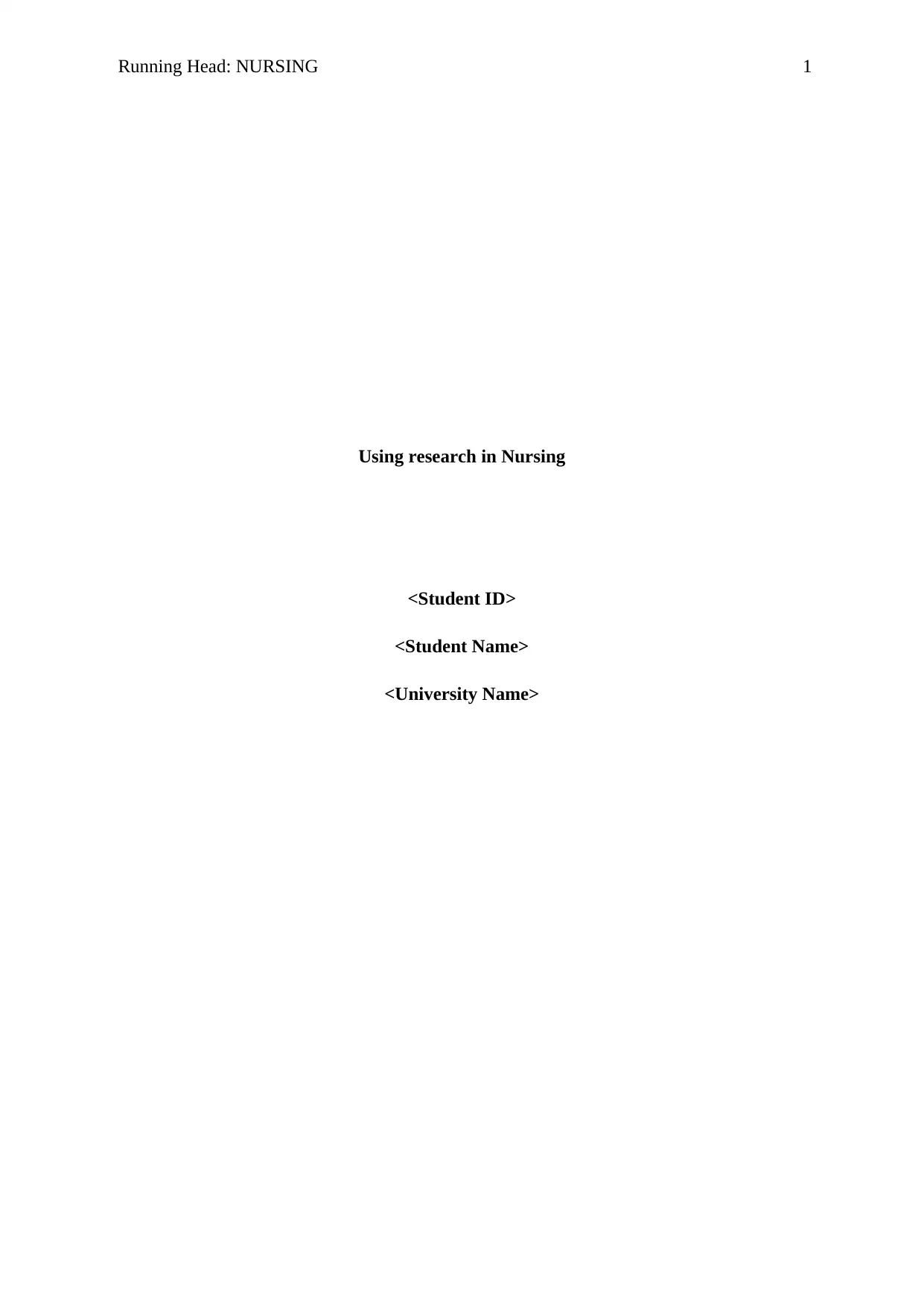
Running Head: NURSING 1
Using research in Nursing
<Student ID>
<Student Name>
<University Name>
Using research in Nursing
<Student ID>
<Student Name>
<University Name>
Paraphrase This Document
Need a fresh take? Get an instant paraphrase of this document with our AI Paraphraser
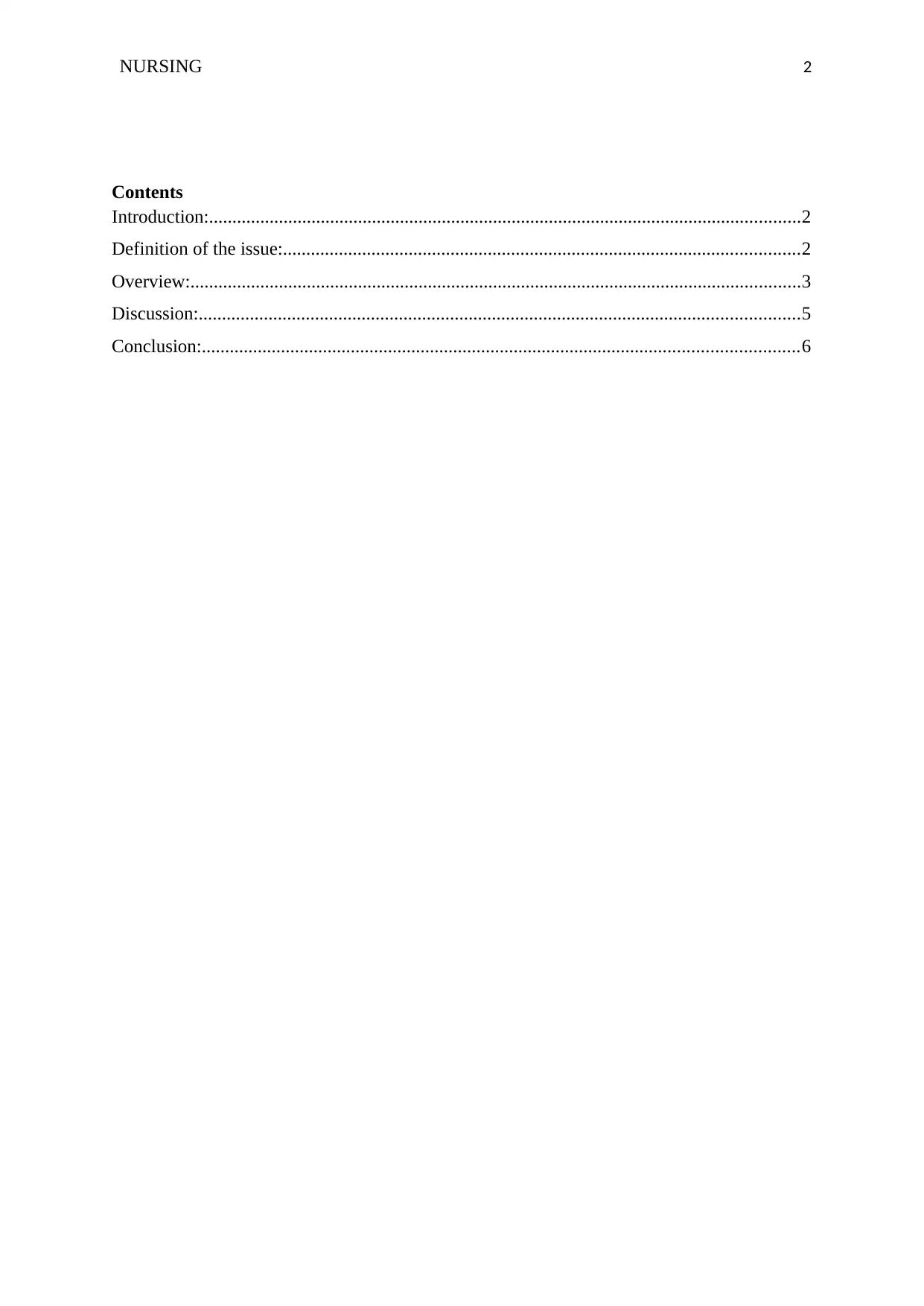
NURSING 2
Contents
Introduction:...............................................................................................................................2
Definition of the issue:...............................................................................................................2
Overview:...................................................................................................................................3
Discussion:.................................................................................................................................5
Conclusion:................................................................................................................................6
Contents
Introduction:...............................................................................................................................2
Definition of the issue:...............................................................................................................2
Overview:...................................................................................................................................3
Discussion:.................................................................................................................................5
Conclusion:................................................................................................................................6
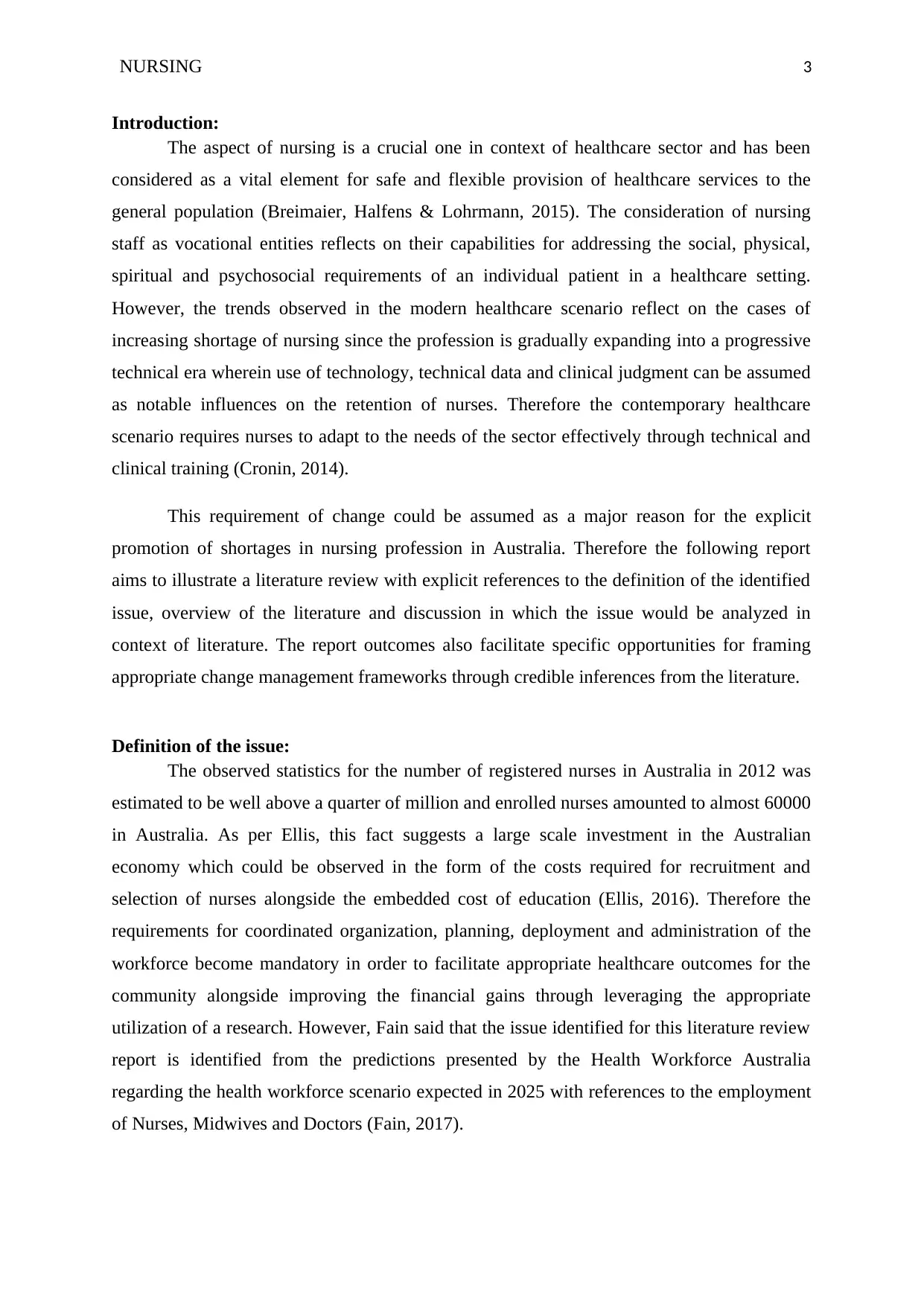
NURSING 3
Introduction:
The aspect of nursing is a crucial one in context of healthcare sector and has been
considered as a vital element for safe and flexible provision of healthcare services to the
general population (Breimaier, Halfens & Lohrmann, 2015). The consideration of nursing
staff as vocational entities reflects on their capabilities for addressing the social, physical,
spiritual and psychosocial requirements of an individual patient in a healthcare setting.
However, the trends observed in the modern healthcare scenario reflect on the cases of
increasing shortage of nursing since the profession is gradually expanding into a progressive
technical era wherein use of technology, technical data and clinical judgment can be assumed
as notable influences on the retention of nurses. Therefore the contemporary healthcare
scenario requires nurses to adapt to the needs of the sector effectively through technical and
clinical training (Cronin, 2014).
This requirement of change could be assumed as a major reason for the explicit
promotion of shortages in nursing profession in Australia. Therefore the following report
aims to illustrate a literature review with explicit references to the definition of the identified
issue, overview of the literature and discussion in which the issue would be analyzed in
context of literature. The report outcomes also facilitate specific opportunities for framing
appropriate change management frameworks through credible inferences from the literature.
Definition of the issue:
The observed statistics for the number of registered nurses in Australia in 2012 was
estimated to be well above a quarter of million and enrolled nurses amounted to almost 60000
in Australia. As per Ellis, this fact suggests a large scale investment in the Australian
economy which could be observed in the form of the costs required for recruitment and
selection of nurses alongside the embedded cost of education (Ellis, 2016). Therefore the
requirements for coordinated organization, planning, deployment and administration of the
workforce become mandatory in order to facilitate appropriate healthcare outcomes for the
community alongside improving the financial gains through leveraging the appropriate
utilization of a research. However, Fain said that the issue identified for this literature review
report is identified from the predictions presented by the Health Workforce Australia
regarding the health workforce scenario expected in 2025 with references to the employment
of Nurses, Midwives and Doctors (Fain, 2017).
Introduction:
The aspect of nursing is a crucial one in context of healthcare sector and has been
considered as a vital element for safe and flexible provision of healthcare services to the
general population (Breimaier, Halfens & Lohrmann, 2015). The consideration of nursing
staff as vocational entities reflects on their capabilities for addressing the social, physical,
spiritual and psychosocial requirements of an individual patient in a healthcare setting.
However, the trends observed in the modern healthcare scenario reflect on the cases of
increasing shortage of nursing since the profession is gradually expanding into a progressive
technical era wherein use of technology, technical data and clinical judgment can be assumed
as notable influences on the retention of nurses. Therefore the contemporary healthcare
scenario requires nurses to adapt to the needs of the sector effectively through technical and
clinical training (Cronin, 2014).
This requirement of change could be assumed as a major reason for the explicit
promotion of shortages in nursing profession in Australia. Therefore the following report
aims to illustrate a literature review with explicit references to the definition of the identified
issue, overview of the literature and discussion in which the issue would be analyzed in
context of literature. The report outcomes also facilitate specific opportunities for framing
appropriate change management frameworks through credible inferences from the literature.
Definition of the issue:
The observed statistics for the number of registered nurses in Australia in 2012 was
estimated to be well above a quarter of million and enrolled nurses amounted to almost 60000
in Australia. As per Ellis, this fact suggests a large scale investment in the Australian
economy which could be observed in the form of the costs required for recruitment and
selection of nurses alongside the embedded cost of education (Ellis, 2016). Therefore the
requirements for coordinated organization, planning, deployment and administration of the
workforce become mandatory in order to facilitate appropriate healthcare outcomes for the
community alongside improving the financial gains through leveraging the appropriate
utilization of a research. However, Fain said that the issue identified for this literature review
report is identified from the predictions presented by the Health Workforce Australia
regarding the health workforce scenario expected in 2025 with references to the employment
of Nurses, Midwives and Doctors (Fain, 2017).
⊘ This is a preview!⊘
Do you want full access?
Subscribe today to unlock all pages.

Trusted by 1+ million students worldwide
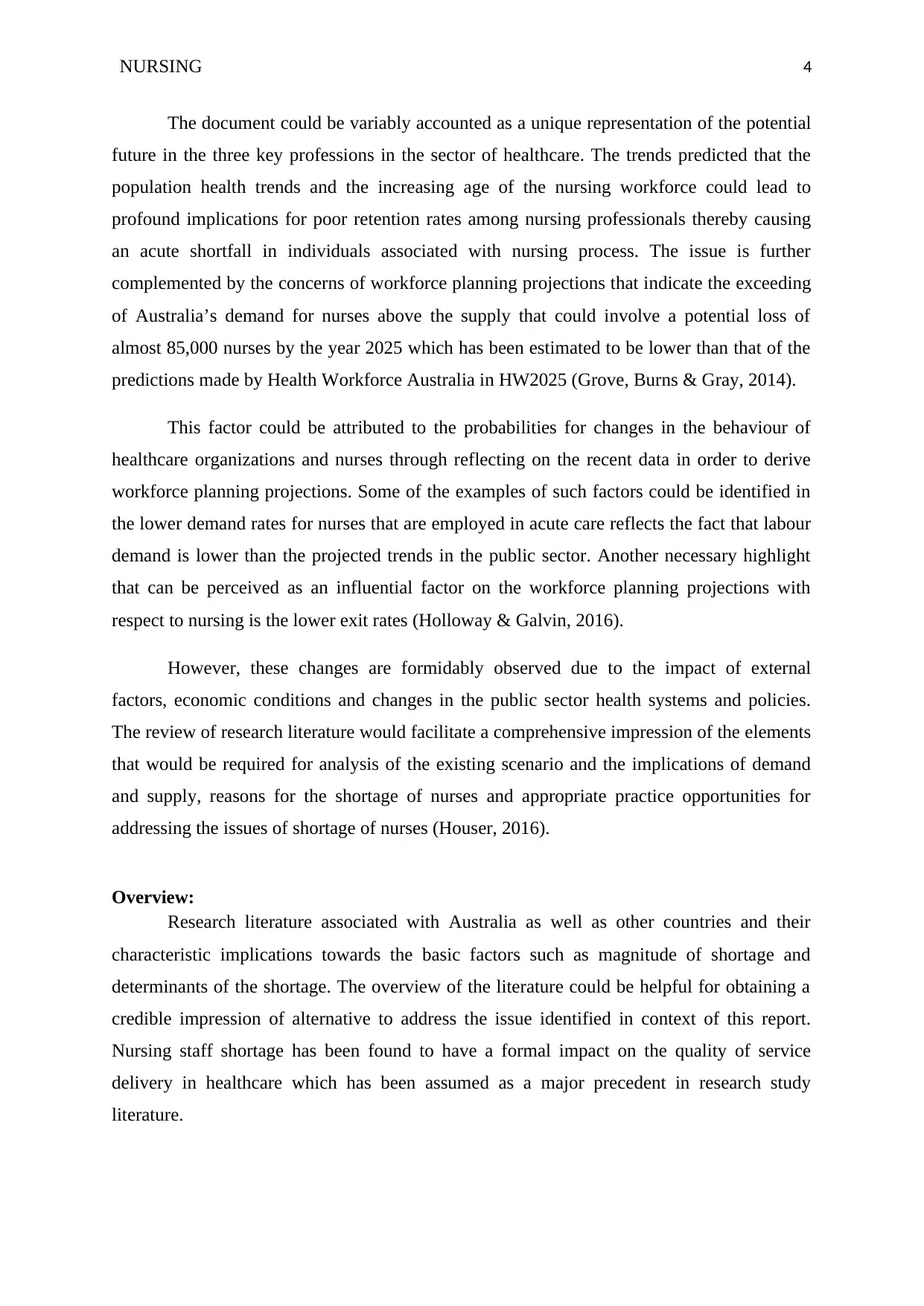
NURSING 4
The document could be variably accounted as a unique representation of the potential
future in the three key professions in the sector of healthcare. The trends predicted that the
population health trends and the increasing age of the nursing workforce could lead to
profound implications for poor retention rates among nursing professionals thereby causing
an acute shortfall in individuals associated with nursing process. The issue is further
complemented by the concerns of workforce planning projections that indicate the exceeding
of Australia’s demand for nurses above the supply that could involve a potential loss of
almost 85,000 nurses by the year 2025 which has been estimated to be lower than that of the
predictions made by Health Workforce Australia in HW2025 (Grove, Burns & Gray, 2014).
This factor could be attributed to the probabilities for changes in the behaviour of
healthcare organizations and nurses through reflecting on the recent data in order to derive
workforce planning projections. Some of the examples of such factors could be identified in
the lower demand rates for nurses that are employed in acute care reflects the fact that labour
demand is lower than the projected trends in the public sector. Another necessary highlight
that can be perceived as an influential factor on the workforce planning projections with
respect to nursing is the lower exit rates (Holloway & Galvin, 2016).
However, these changes are formidably observed due to the impact of external
factors, economic conditions and changes in the public sector health systems and policies.
The review of research literature would facilitate a comprehensive impression of the elements
that would be required for analysis of the existing scenario and the implications of demand
and supply, reasons for the shortage of nurses and appropriate practice opportunities for
addressing the issues of shortage of nurses (Houser, 2016).
Overview:
Research literature associated with Australia as well as other countries and their
characteristic implications towards the basic factors such as magnitude of shortage and
determinants of the shortage. The overview of the literature could be helpful for obtaining a
credible impression of alternative to address the issue identified in context of this report.
Nursing staff shortage has been found to have a formal impact on the quality of service
delivery in healthcare which has been assumed as a major precedent in research study
literature.
The document could be variably accounted as a unique representation of the potential
future in the three key professions in the sector of healthcare. The trends predicted that the
population health trends and the increasing age of the nursing workforce could lead to
profound implications for poor retention rates among nursing professionals thereby causing
an acute shortfall in individuals associated with nursing process. The issue is further
complemented by the concerns of workforce planning projections that indicate the exceeding
of Australia’s demand for nurses above the supply that could involve a potential loss of
almost 85,000 nurses by the year 2025 which has been estimated to be lower than that of the
predictions made by Health Workforce Australia in HW2025 (Grove, Burns & Gray, 2014).
This factor could be attributed to the probabilities for changes in the behaviour of
healthcare organizations and nurses through reflecting on the recent data in order to derive
workforce planning projections. Some of the examples of such factors could be identified in
the lower demand rates for nurses that are employed in acute care reflects the fact that labour
demand is lower than the projected trends in the public sector. Another necessary highlight
that can be perceived as an influential factor on the workforce planning projections with
respect to nursing is the lower exit rates (Holloway & Galvin, 2016).
However, these changes are formidably observed due to the impact of external
factors, economic conditions and changes in the public sector health systems and policies.
The review of research literature would facilitate a comprehensive impression of the elements
that would be required for analysis of the existing scenario and the implications of demand
and supply, reasons for the shortage of nurses and appropriate practice opportunities for
addressing the issues of shortage of nurses (Houser, 2016).
Overview:
Research literature associated with Australia as well as other countries and their
characteristic implications towards the basic factors such as magnitude of shortage and
determinants of the shortage. The overview of the literature could be helpful for obtaining a
credible impression of alternative to address the issue identified in context of this report.
Nursing staff shortage has been found to have a formal impact on the quality of service
delivery in healthcare which has been assumed as a major precedent in research study
literature.
Paraphrase This Document
Need a fresh take? Get an instant paraphrase of this document with our AI Paraphraser
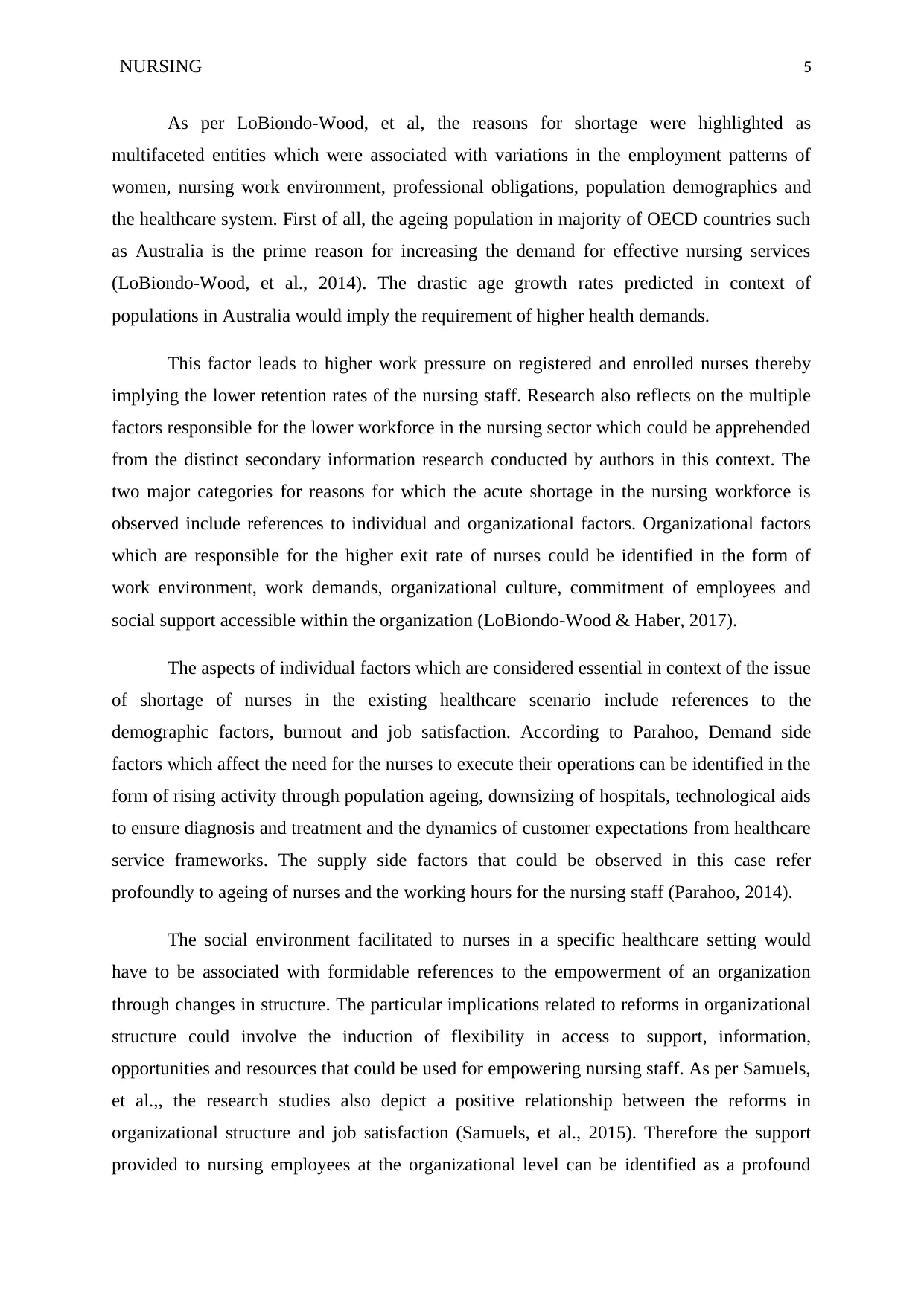
NURSING 5
As per LoBiondo-Wood, et al, the reasons for shortage were highlighted as
multifaceted entities which were associated with variations in the employment patterns of
women, nursing work environment, professional obligations, population demographics and
the healthcare system. First of all, the ageing population in majority of OECD countries such
as Australia is the prime reason for increasing the demand for effective nursing services
(LoBiondo-Wood, et al., 2014). The drastic age growth rates predicted in context of
populations in Australia would imply the requirement of higher health demands.
This factor leads to higher work pressure on registered and enrolled nurses thereby
implying the lower retention rates of the nursing staff. Research also reflects on the multiple
factors responsible for the lower workforce in the nursing sector which could be apprehended
from the distinct secondary information research conducted by authors in this context. The
two major categories for reasons for which the acute shortage in the nursing workforce is
observed include references to individual and organizational factors. Organizational factors
which are responsible for the higher exit rate of nurses could be identified in the form of
work environment, work demands, organizational culture, commitment of employees and
social support accessible within the organization (LoBiondo-Wood & Haber, 2017).
The aspects of individual factors which are considered essential in context of the issue
of shortage of nurses in the existing healthcare scenario include references to the
demographic factors, burnout and job satisfaction. According to Parahoo, Demand side
factors which affect the need for the nurses to execute their operations can be identified in the
form of rising activity through population ageing, downsizing of hospitals, technological aids
to ensure diagnosis and treatment and the dynamics of customer expectations from healthcare
service frameworks. The supply side factors that could be observed in this case refer
profoundly to ageing of nurses and the working hours for the nursing staff (Parahoo, 2014).
The social environment facilitated to nurses in a specific healthcare setting would
have to be associated with formidable references to the empowerment of an organization
through changes in structure. The particular implications related to reforms in organizational
structure could involve the induction of flexibility in access to support, information,
opportunities and resources that could be used for empowering nursing staff. As per Samuels,
et al.,, the research studies also depict a positive relationship between the reforms in
organizational structure and job satisfaction (Samuels, et al., 2015). Therefore the support
provided to nursing employees at the organizational level can be identified as a profound
As per LoBiondo-Wood, et al, the reasons for shortage were highlighted as
multifaceted entities which were associated with variations in the employment patterns of
women, nursing work environment, professional obligations, population demographics and
the healthcare system. First of all, the ageing population in majority of OECD countries such
as Australia is the prime reason for increasing the demand for effective nursing services
(LoBiondo-Wood, et al., 2014). The drastic age growth rates predicted in context of
populations in Australia would imply the requirement of higher health demands.
This factor leads to higher work pressure on registered and enrolled nurses thereby
implying the lower retention rates of the nursing staff. Research also reflects on the multiple
factors responsible for the lower workforce in the nursing sector which could be apprehended
from the distinct secondary information research conducted by authors in this context. The
two major categories for reasons for which the acute shortage in the nursing workforce is
observed include references to individual and organizational factors. Organizational factors
which are responsible for the higher exit rate of nurses could be identified in the form of
work environment, work demands, organizational culture, commitment of employees and
social support accessible within the organization (LoBiondo-Wood & Haber, 2017).
The aspects of individual factors which are considered essential in context of the issue
of shortage of nurses in the existing healthcare scenario include references to the
demographic factors, burnout and job satisfaction. According to Parahoo, Demand side
factors which affect the need for the nurses to execute their operations can be identified in the
form of rising activity through population ageing, downsizing of hospitals, technological aids
to ensure diagnosis and treatment and the dynamics of customer expectations from healthcare
service frameworks. The supply side factors that could be observed in this case refer
profoundly to ageing of nurses and the working hours for the nursing staff (Parahoo, 2014).
The social environment facilitated to nurses in a specific healthcare setting would
have to be associated with formidable references to the empowerment of an organization
through changes in structure. The particular implications related to reforms in organizational
structure could involve the induction of flexibility in access to support, information,
opportunities and resources that could be used for empowering nursing staff. As per Samuels,
et al.,, the research studies also depict a positive relationship between the reforms in
organizational structure and job satisfaction (Samuels, et al., 2015). Therefore the support
provided to nursing employees at the organizational level can be identified as a profound
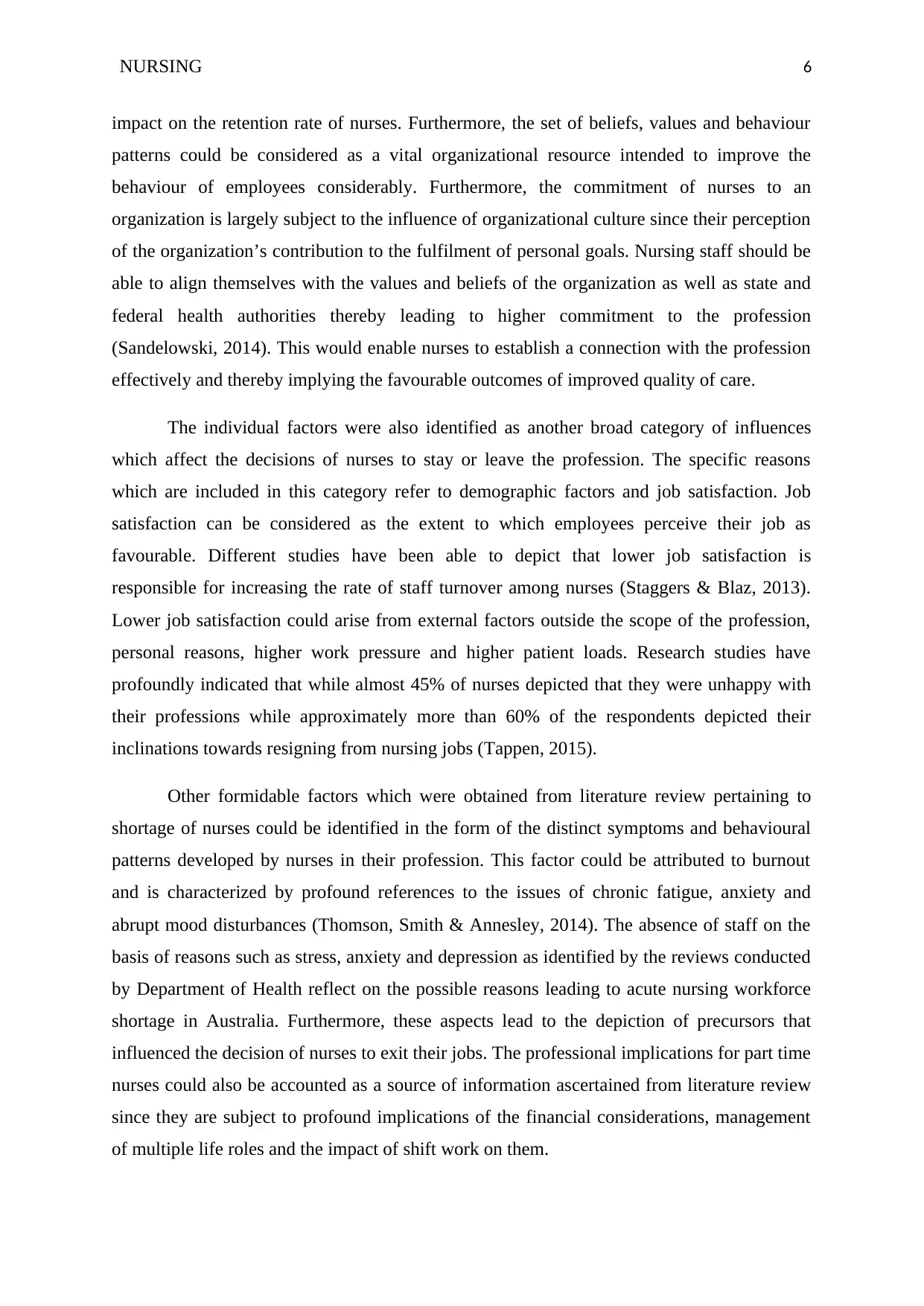
NURSING 6
impact on the retention rate of nurses. Furthermore, the set of beliefs, values and behaviour
patterns could be considered as a vital organizational resource intended to improve the
behaviour of employees considerably. Furthermore, the commitment of nurses to an
organization is largely subject to the influence of organizational culture since their perception
of the organization’s contribution to the fulfilment of personal goals. Nursing staff should be
able to align themselves with the values and beliefs of the organization as well as state and
federal health authorities thereby leading to higher commitment to the profession
(Sandelowski, 2014). This would enable nurses to establish a connection with the profession
effectively and thereby implying the favourable outcomes of improved quality of care.
The individual factors were also identified as another broad category of influences
which affect the decisions of nurses to stay or leave the profession. The specific reasons
which are included in this category refer to demographic factors and job satisfaction. Job
satisfaction can be considered as the extent to which employees perceive their job as
favourable. Different studies have been able to depict that lower job satisfaction is
responsible for increasing the rate of staff turnover among nurses (Staggers & Blaz, 2013).
Lower job satisfaction could arise from external factors outside the scope of the profession,
personal reasons, higher work pressure and higher patient loads. Research studies have
profoundly indicated that while almost 45% of nurses depicted that they were unhappy with
their professions while approximately more than 60% of the respondents depicted their
inclinations towards resigning from nursing jobs (Tappen, 2015).
Other formidable factors which were obtained from literature review pertaining to
shortage of nurses could be identified in the form of the distinct symptoms and behavioural
patterns developed by nurses in their profession. This factor could be attributed to burnout
and is characterized by profound references to the issues of chronic fatigue, anxiety and
abrupt mood disturbances (Thomson, Smith & Annesley, 2014). The absence of staff on the
basis of reasons such as stress, anxiety and depression as identified by the reviews conducted
by Department of Health reflect on the possible reasons leading to acute nursing workforce
shortage in Australia. Furthermore, these aspects lead to the depiction of precursors that
influenced the decision of nurses to exit their jobs. The professional implications for part time
nurses could also be accounted as a source of information ascertained from literature review
since they are subject to profound implications of the financial considerations, management
of multiple life roles and the impact of shift work on them.
impact on the retention rate of nurses. Furthermore, the set of beliefs, values and behaviour
patterns could be considered as a vital organizational resource intended to improve the
behaviour of employees considerably. Furthermore, the commitment of nurses to an
organization is largely subject to the influence of organizational culture since their perception
of the organization’s contribution to the fulfilment of personal goals. Nursing staff should be
able to align themselves with the values and beliefs of the organization as well as state and
federal health authorities thereby leading to higher commitment to the profession
(Sandelowski, 2014). This would enable nurses to establish a connection with the profession
effectively and thereby implying the favourable outcomes of improved quality of care.
The individual factors were also identified as another broad category of influences
which affect the decisions of nurses to stay or leave the profession. The specific reasons
which are included in this category refer to demographic factors and job satisfaction. Job
satisfaction can be considered as the extent to which employees perceive their job as
favourable. Different studies have been able to depict that lower job satisfaction is
responsible for increasing the rate of staff turnover among nurses (Staggers & Blaz, 2013).
Lower job satisfaction could arise from external factors outside the scope of the profession,
personal reasons, higher work pressure and higher patient loads. Research studies have
profoundly indicated that while almost 45% of nurses depicted that they were unhappy with
their professions while approximately more than 60% of the respondents depicted their
inclinations towards resigning from nursing jobs (Tappen, 2015).
Other formidable factors which were obtained from literature review pertaining to
shortage of nurses could be identified in the form of the distinct symptoms and behavioural
patterns developed by nurses in their profession. This factor could be attributed to burnout
and is characterized by profound references to the issues of chronic fatigue, anxiety and
abrupt mood disturbances (Thomson, Smith & Annesley, 2014). The absence of staff on the
basis of reasons such as stress, anxiety and depression as identified by the reviews conducted
by Department of Health reflect on the possible reasons leading to acute nursing workforce
shortage in Australia. Furthermore, these aspects lead to the depiction of precursors that
influenced the decision of nurses to exit their jobs. The professional implications for part time
nurses could also be accounted as a source of information ascertained from literature review
since they are subject to profound implications of the financial considerations, management
of multiple life roles and the impact of shift work on them.
⊘ This is a preview!⊘
Do you want full access?
Subscribe today to unlock all pages.

Trusted by 1+ million students worldwide
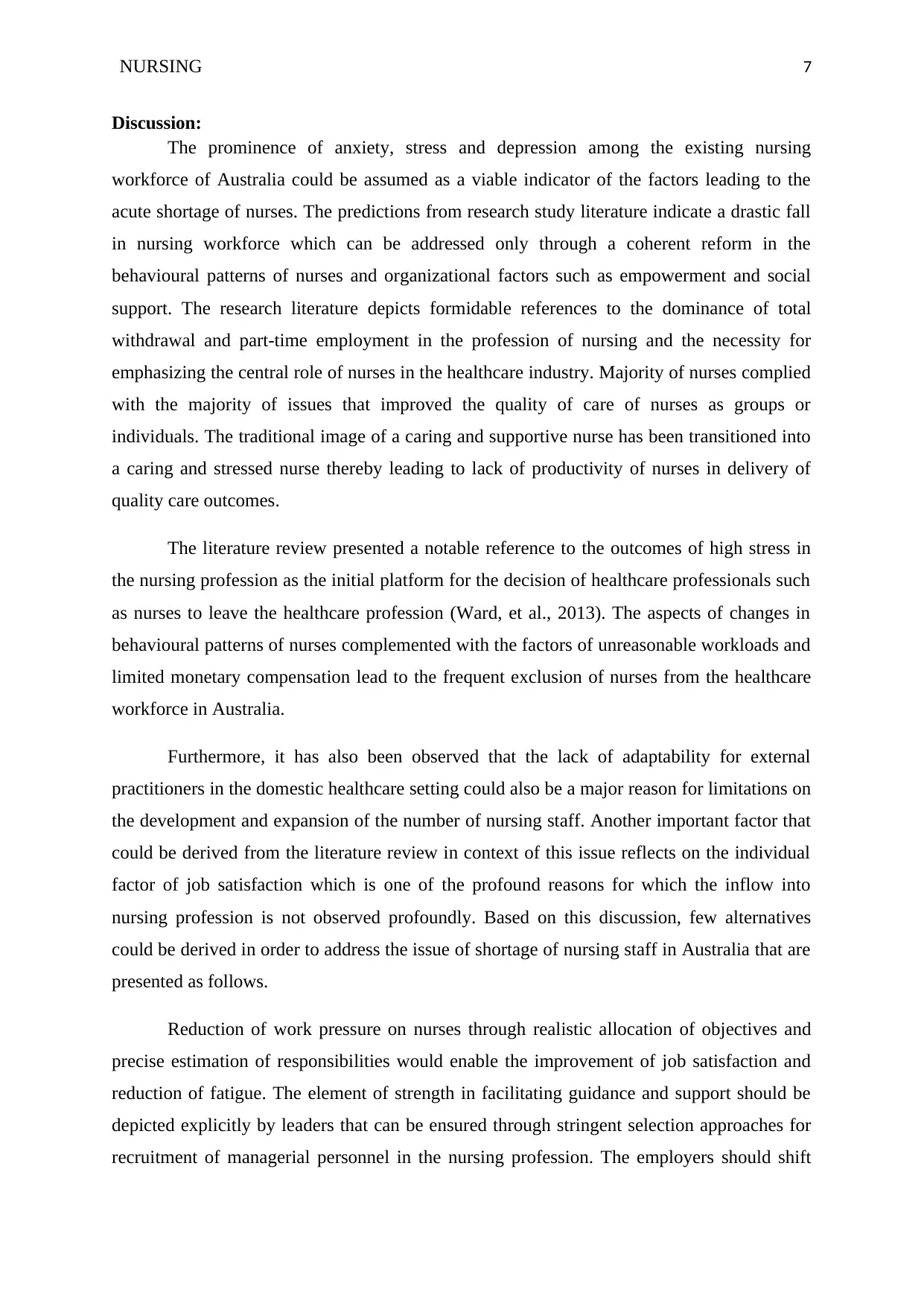
NURSING 7
Discussion:
The prominence of anxiety, stress and depression among the existing nursing
workforce of Australia could be assumed as a viable indicator of the factors leading to the
acute shortage of nurses. The predictions from research study literature indicate a drastic fall
in nursing workforce which can be addressed only through a coherent reform in the
behavioural patterns of nurses and organizational factors such as empowerment and social
support. The research literature depicts formidable references to the dominance of total
withdrawal and part-time employment in the profession of nursing and the necessity for
emphasizing the central role of nurses in the healthcare industry. Majority of nurses complied
with the majority of issues that improved the quality of care of nurses as groups or
individuals. The traditional image of a caring and supportive nurse has been transitioned into
a caring and stressed nurse thereby leading to lack of productivity of nurses in delivery of
quality care outcomes.
The literature review presented a notable reference to the outcomes of high stress in
the nursing profession as the initial platform for the decision of healthcare professionals such
as nurses to leave the healthcare profession (Ward, et al., 2013). The aspects of changes in
behavioural patterns of nurses complemented with the factors of unreasonable workloads and
limited monetary compensation lead to the frequent exclusion of nurses from the healthcare
workforce in Australia.
Furthermore, it has also been observed that the lack of adaptability for external
practitioners in the domestic healthcare setting could also be a major reason for limitations on
the development and expansion of the number of nursing staff. Another important factor that
could be derived from the literature review in context of this issue reflects on the individual
factor of job satisfaction which is one of the profound reasons for which the inflow into
nursing profession is not observed profoundly. Based on this discussion, few alternatives
could be derived in order to address the issue of shortage of nursing staff in Australia that are
presented as follows.
Reduction of work pressure on nurses through realistic allocation of objectives and
precise estimation of responsibilities would enable the improvement of job satisfaction and
reduction of fatigue. The element of strength in facilitating guidance and support should be
depicted explicitly by leaders that can be ensured through stringent selection approaches for
recruitment of managerial personnel in the nursing profession. The employers should shift
Discussion:
The prominence of anxiety, stress and depression among the existing nursing
workforce of Australia could be assumed as a viable indicator of the factors leading to the
acute shortage of nurses. The predictions from research study literature indicate a drastic fall
in nursing workforce which can be addressed only through a coherent reform in the
behavioural patterns of nurses and organizational factors such as empowerment and social
support. The research literature depicts formidable references to the dominance of total
withdrawal and part-time employment in the profession of nursing and the necessity for
emphasizing the central role of nurses in the healthcare industry. Majority of nurses complied
with the majority of issues that improved the quality of care of nurses as groups or
individuals. The traditional image of a caring and supportive nurse has been transitioned into
a caring and stressed nurse thereby leading to lack of productivity of nurses in delivery of
quality care outcomes.
The literature review presented a notable reference to the outcomes of high stress in
the nursing profession as the initial platform for the decision of healthcare professionals such
as nurses to leave the healthcare profession (Ward, et al., 2013). The aspects of changes in
behavioural patterns of nurses complemented with the factors of unreasonable workloads and
limited monetary compensation lead to the frequent exclusion of nurses from the healthcare
workforce in Australia.
Furthermore, it has also been observed that the lack of adaptability for external
practitioners in the domestic healthcare setting could also be a major reason for limitations on
the development and expansion of the number of nursing staff. Another important factor that
could be derived from the literature review in context of this issue reflects on the individual
factor of job satisfaction which is one of the profound reasons for which the inflow into
nursing profession is not observed profoundly. Based on this discussion, few alternatives
could be derived in order to address the issue of shortage of nursing staff in Australia that are
presented as follows.
Reduction of work pressure on nurses through realistic allocation of objectives and
precise estimation of responsibilities would enable the improvement of job satisfaction and
reduction of fatigue. The element of strength in facilitating guidance and support should be
depicted explicitly by leaders that can be ensured through stringent selection approaches for
recruitment of managerial personnel in the nursing profession. The employers should shift
Paraphrase This Document
Need a fresh take? Get an instant paraphrase of this document with our AI Paraphraser
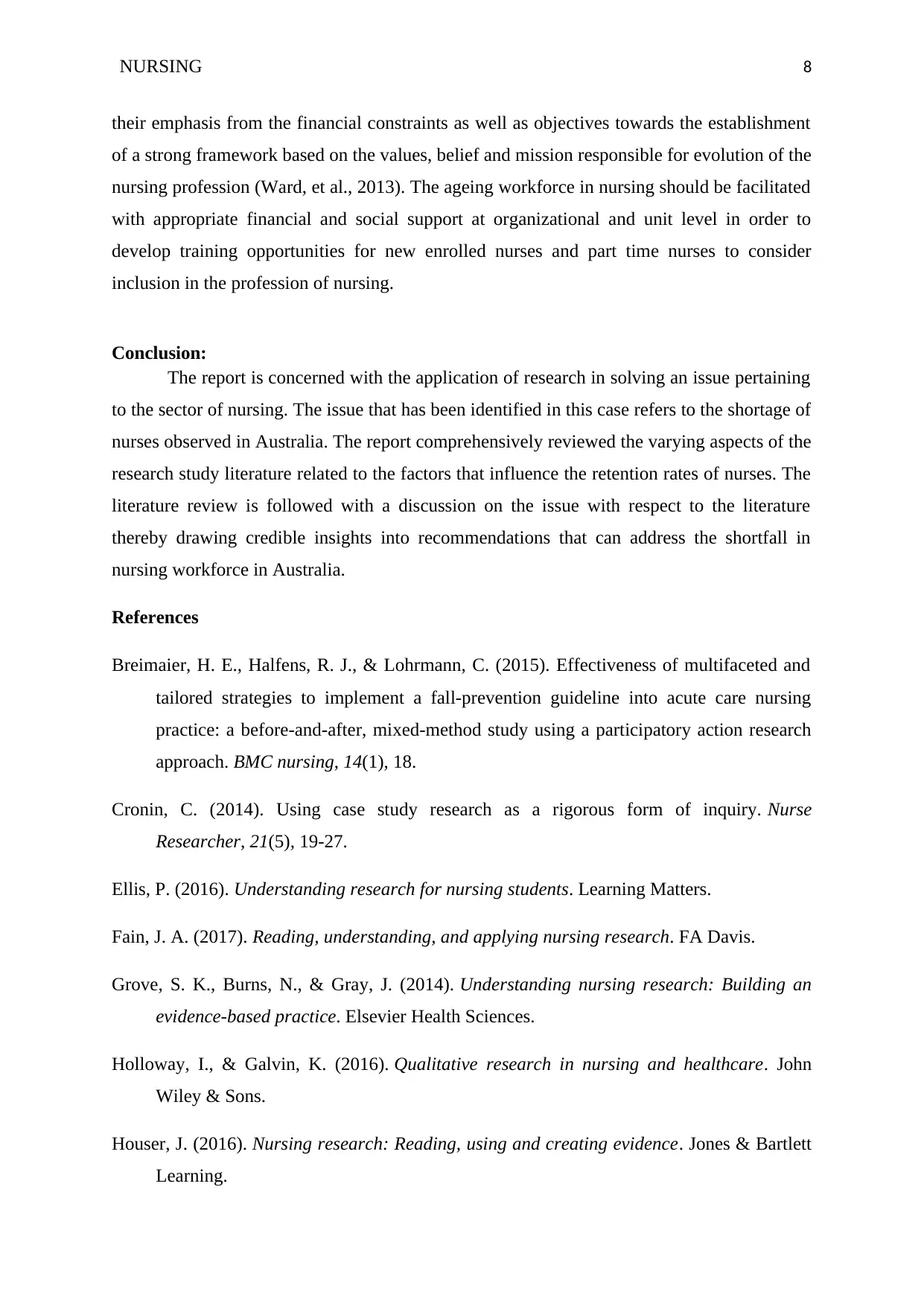
NURSING 8
their emphasis from the financial constraints as well as objectives towards the establishment
of a strong framework based on the values, belief and mission responsible for evolution of the
nursing profession (Ward, et al., 2013). The ageing workforce in nursing should be facilitated
with appropriate financial and social support at organizational and unit level in order to
develop training opportunities for new enrolled nurses and part time nurses to consider
inclusion in the profession of nursing.
Conclusion:
The report is concerned with the application of research in solving an issue pertaining
to the sector of nursing. The issue that has been identified in this case refers to the shortage of
nurses observed in Australia. The report comprehensively reviewed the varying aspects of the
research study literature related to the factors that influence the retention rates of nurses. The
literature review is followed with a discussion on the issue with respect to the literature
thereby drawing credible insights into recommendations that can address the shortfall in
nursing workforce in Australia.
References
Breimaier, H. E., Halfens, R. J., & Lohrmann, C. (2015). Effectiveness of multifaceted and
tailored strategies to implement a fall-prevention guideline into acute care nursing
practice: a before-and-after, mixed-method study using a participatory action research
approach. BMC nursing, 14(1), 18.
Cronin, C. (2014). Using case study research as a rigorous form of inquiry. Nurse
Researcher, 21(5), 19-27.
Ellis, P. (2016). Understanding research for nursing students. Learning Matters.
Fain, J. A. (2017). Reading, understanding, and applying nursing research. FA Davis.
Grove, S. K., Burns, N., & Gray, J. (2014). Understanding nursing research: Building an
evidence-based practice. Elsevier Health Sciences.
Holloway, I., & Galvin, K. (2016). Qualitative research in nursing and healthcare. John
Wiley & Sons.
Houser, J. (2016). Nursing research: Reading, using and creating evidence. Jones & Bartlett
Learning.
their emphasis from the financial constraints as well as objectives towards the establishment
of a strong framework based on the values, belief and mission responsible for evolution of the
nursing profession (Ward, et al., 2013). The ageing workforce in nursing should be facilitated
with appropriate financial and social support at organizational and unit level in order to
develop training opportunities for new enrolled nurses and part time nurses to consider
inclusion in the profession of nursing.
Conclusion:
The report is concerned with the application of research in solving an issue pertaining
to the sector of nursing. The issue that has been identified in this case refers to the shortage of
nurses observed in Australia. The report comprehensively reviewed the varying aspects of the
research study literature related to the factors that influence the retention rates of nurses. The
literature review is followed with a discussion on the issue with respect to the literature
thereby drawing credible insights into recommendations that can address the shortfall in
nursing workforce in Australia.
References
Breimaier, H. E., Halfens, R. J., & Lohrmann, C. (2015). Effectiveness of multifaceted and
tailored strategies to implement a fall-prevention guideline into acute care nursing
practice: a before-and-after, mixed-method study using a participatory action research
approach. BMC nursing, 14(1), 18.
Cronin, C. (2014). Using case study research as a rigorous form of inquiry. Nurse
Researcher, 21(5), 19-27.
Ellis, P. (2016). Understanding research for nursing students. Learning Matters.
Fain, J. A. (2017). Reading, understanding, and applying nursing research. FA Davis.
Grove, S. K., Burns, N., & Gray, J. (2014). Understanding nursing research: Building an
evidence-based practice. Elsevier Health Sciences.
Holloway, I., & Galvin, K. (2016). Qualitative research in nursing and healthcare. John
Wiley & Sons.
Houser, J. (2016). Nursing research: Reading, using and creating evidence. Jones & Bartlett
Learning.
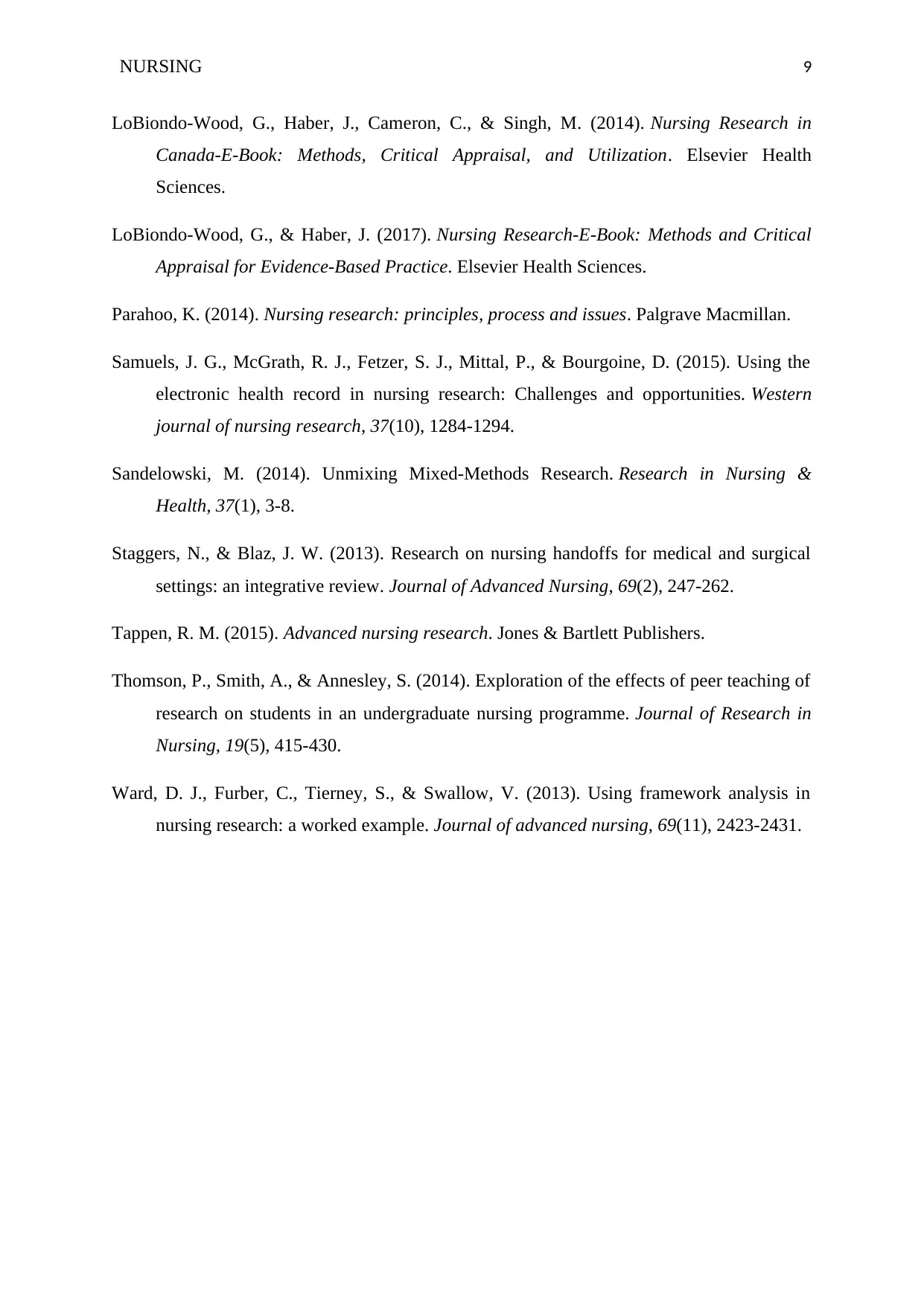
NURSING 9
LoBiondo-Wood, G., Haber, J., Cameron, C., & Singh, M. (2014). Nursing Research in
Canada-E-Book: Methods, Critical Appraisal, and Utilization. Elsevier Health
Sciences.
LoBiondo-Wood, G., & Haber, J. (2017). Nursing Research-E-Book: Methods and Critical
Appraisal for Evidence-Based Practice. Elsevier Health Sciences.
Parahoo, K. (2014). Nursing research: principles, process and issues. Palgrave Macmillan.
Samuels, J. G., McGrath, R. J., Fetzer, S. J., Mittal, P., & Bourgoine, D. (2015). Using the
electronic health record in nursing research: Challenges and opportunities. Western
journal of nursing research, 37(10), 1284-1294.
Sandelowski, M. (2014). Unmixing Mixed‐Methods Research. Research in Nursing &
Health, 37(1), 3-8.
Staggers, N., & Blaz, J. W. (2013). Research on nursing handoffs for medical and surgical
settings: an integrative review. Journal of Advanced Nursing, 69(2), 247-262.
Tappen, R. M. (2015). Advanced nursing research. Jones & Bartlett Publishers.
Thomson, P., Smith, A., & Annesley, S. (2014). Exploration of the effects of peer teaching of
research on students in an undergraduate nursing programme. Journal of Research in
Nursing, 19(5), 415-430.
Ward, D. J., Furber, C., Tierney, S., & Swallow, V. (2013). Using framework analysis in
nursing research: a worked example. Journal of advanced nursing, 69(11), 2423-2431.
LoBiondo-Wood, G., Haber, J., Cameron, C., & Singh, M. (2014). Nursing Research in
Canada-E-Book: Methods, Critical Appraisal, and Utilization. Elsevier Health
Sciences.
LoBiondo-Wood, G., & Haber, J. (2017). Nursing Research-E-Book: Methods and Critical
Appraisal for Evidence-Based Practice. Elsevier Health Sciences.
Parahoo, K. (2014). Nursing research: principles, process and issues. Palgrave Macmillan.
Samuels, J. G., McGrath, R. J., Fetzer, S. J., Mittal, P., & Bourgoine, D. (2015). Using the
electronic health record in nursing research: Challenges and opportunities. Western
journal of nursing research, 37(10), 1284-1294.
Sandelowski, M. (2014). Unmixing Mixed‐Methods Research. Research in Nursing &
Health, 37(1), 3-8.
Staggers, N., & Blaz, J. W. (2013). Research on nursing handoffs for medical and surgical
settings: an integrative review. Journal of Advanced Nursing, 69(2), 247-262.
Tappen, R. M. (2015). Advanced nursing research. Jones & Bartlett Publishers.
Thomson, P., Smith, A., & Annesley, S. (2014). Exploration of the effects of peer teaching of
research on students in an undergraduate nursing programme. Journal of Research in
Nursing, 19(5), 415-430.
Ward, D. J., Furber, C., Tierney, S., & Swallow, V. (2013). Using framework analysis in
nursing research: a worked example. Journal of advanced nursing, 69(11), 2423-2431.
⊘ This is a preview!⊘
Do you want full access?
Subscribe today to unlock all pages.

Trusted by 1+ million students worldwide
1 out of 9
Your All-in-One AI-Powered Toolkit for Academic Success.
+13062052269
info@desklib.com
Available 24*7 on WhatsApp / Email
![[object Object]](/_next/static/media/star-bottom.7253800d.svg)
Unlock your academic potential
Copyright © 2020–2025 A2Z Services. All Rights Reserved. Developed and managed by ZUCOL.

